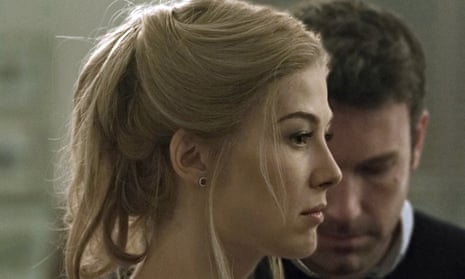Just call it the Gone Girl effect. Following the success of Gillian Flynn’s bestselling novel and the recent acclaimed David Fincher-directed film adaptation, fiction in 2015 is set to be dominated by unreliable women.
From Rachel Watson, the unhappy heroine of British writer Paula Hawkins’s much-anticipated debut novel The Girl on the Train, to Anna Benz, the depressed wife at the heart of Jill Alexander Essbaum’s haunting Hausfrau, this year’s most compelling reads are all about lost girls, some of whom, like Flynn’s Amy Dunne, turn out to have a core of steel in their soul.
“It certainly feels as though since Gone Girl we’ve all been talking about these types of characters more,” says Sarah Adams, publishing director at Transworld. “I wouldn’t say I was consciously looking for them, but I think the publishing world is maybe more aware that these types of characters can be interesting.”
Yet this shift is not so much about readers’ desire to read about women behaving badly as it is about a new thirst for realism and an acknowledgement that we all have flaws. “What I find intriguing as an editor is what happens when you experience a gradual loss of control following an unexpected event,” says Adams. “It’s the idea that this is a scenario we could all relate to, but then something happens that takes it just that bit further beyond our experience.”
And there’s clearly a growing market for such tales. When Sheila O’Reilly, owner of the independent Dulwich Books in south-east London, announced two meet-the-author events featuring female crime writers – Thrillers, Tarts & Tanqueray, with Christobel Kent, Colette McBeth and Rebecca Whitney; and Murder & Martinis with Hawkins and SJ Watson, the (male) author of the thriller Before I Go To Sleep – both sold out in days.
“I firmly believe 2015 will be the year when British thriller writers step up to a standard demanded by readers and strike back against the Scandinavian and American deluge we’ve experienced over the past few years,” says O’Reilly. “With the books I’ve read in the past month I feel that the quality of writing, the plot development and the sense of plot have really improved dramatically. Is it driven by Gone Girl? Yes, because publishers see that Gone Girl came out two years ago but it’s still a bestseller, so they’re hoping for that success.”
Hawkins, whose addictive debut The Girl on the Train was the subject of a four-way bid between major publishing houses before going to Transworld in a “substantial” deal, agrees that there has been a sea change in the way female protagonists are perceived.
“I wasn’t conscious of being part of a particular wave of crime novels when I was writing The Girl on the Train but I think there has been a shift towards realism in crime writing lately,” she says. “When you have a huge bestseller like Gone Girl, which has at its heart a deeply flawed female protagonist, people start to sit up and take notice.”

Yet while Gone Girl’s success may have helped bring them attention, none of these novels is simply a ripoff of Flynn’s tale. Thus Whitney’s The Liar’s Chair may, like Gone Girl, have a toxic marriage at its heart, but the story Whitney tells is of a woman who has lost the ability to connect to anything in her life. Adrift from everything, including her emotions, Rachel haunts her own story, wrongfooting the reader throughout. “I have had quite a few reviews which say ‘I hated all the characters’,” admits Whitney. “I hope that as they read on they see that Rachel is deeply flawed, but that there are reasons for that.”
Like many of the new breed of bad girl stories, Rachel’s draws its power not so much from her bad behaviour – drugs, drink and casual sex – but from the convincingly claustrophobic details of her home life. Where fictional anti-heroes live their lives in public, making their mistakes at work or walking down Philip Marlowe’s mean streets, these anti-heroines operate in a domestic sphere.
“What interests me is something that all looks perfectly normal but isn’t,” says Renée Knight, whose debut Disclaimer is published by Doubleday and out in April. “Rooting a story in domestic life makes it more accessible, but it’s also about stripping away privacy and the idea that ultimately your home should be a place of safety.”
That idea of the home as an oppressive rather than welcoming place forms a common thread through all these novels, most chillingly in Essbaum’s Hausfrau, in which the depressed Anna drifts through her affluent Swiss life like a less vivacious Emma Bovary, destroying her life one small misstep at a time.
“She’s a train wreck,” admits Essbaum, adding that the appeal of the neurotic anti-heroine is that, much as we deny it, we all recognise part of her in ourselves. “Anna is the friend we all talk about behind her back. You may not like her, but you can’t look away because you recognise a little sliver of yourself in her. We all behave badly. We may not screw around on our husbands but a lie is a lie – it doesn’t matter whether big or small.”And ultimately it’s that nasty little twinge of recognition that drives the huge sales. “I love reading about people who are like me in real scenarios that I can completely imagine,” admits Transworld’s Adams. “It’s not so much about the investigation of a mystery as it is about psychology and the shifting of what we think to be true – until we don’t know who to trust and, intoxicatingly, neither does the character.”

Comments (…)
Sign in or create your Guardian account to join the discussion